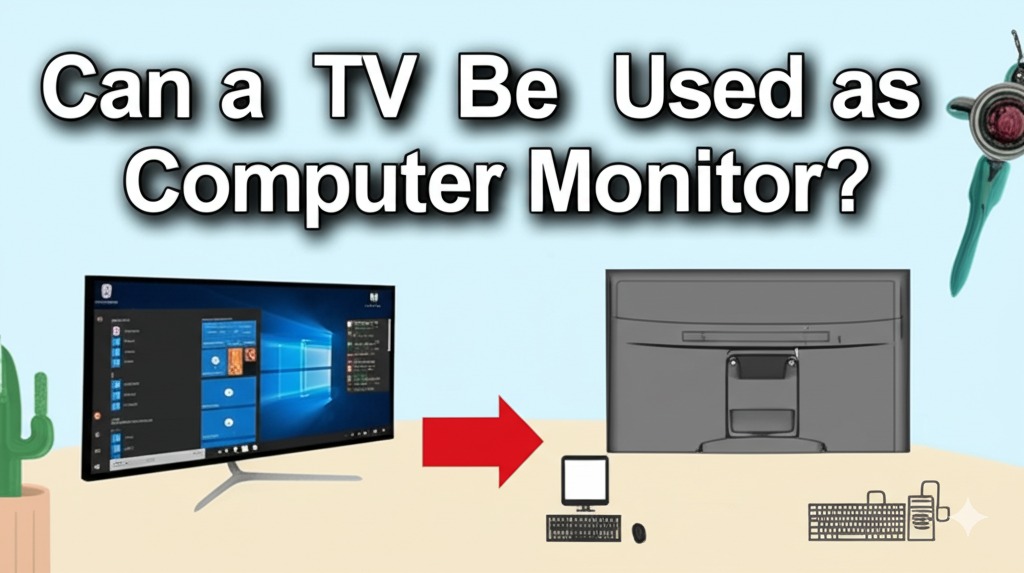In an age of hybrid workspaces, gaming setups, and home entertainment systems, it’s no surprise people are asking: Can a TV be used as a computer monitor? The short answer is yes—but with some important considerations. Whether you’re trying to maximize screen real estate, create a budget-friendly workstation, or simply curious about the possibilities, this guide will walk you through everything you need to know.
Why Consider Using a TV as a Monitor?
Using a TV instead of a traditional monitor can be a cost-effective and immersive option, especially if you already own a high-definition or 4K television. Here are a few common reasons people explore this setup:
- Bigger screen size for multitasking, gaming, or watching videos.
- Convenience—using what you already have saves money.
- Smart TV features that offer streaming and browsing options in one device.
But before you plug in your HDMI cable, there are several key factors to weigh.
Key Considerations Before Using a TV as a Monitor
1. Display Resolution and Size
One of the biggest differences between a monitor and a TV is pixel density.
- Monitors typically have a higher pixel density, which means sharper text and clearer images at closer viewing distances.
- TVs, especially those 40 inches or larger, are meant to be viewed from a distance. Using them up close may result in blurry or pixelated visuals.
Tip: For desktop use, a 4K TV (3840×2160 resolution) at 40–50 inches offers a decent balance of screen size and sharpness.
2. Input Lag and Refresh Rate
- Input lag refers to the delay between an action (like moving your mouse) and seeing the result on screen. Some TVs—especially budget models—have higher input lag, making them less ideal for gaming or design work.
- Check if your TV has a “Game Mode”—this reduces post-processing and lowers input lag.
- Look for TVs with 60Hz or higher refresh rates for smoother visuals.
3. Ports and Connectivity
Ensure your TV has the right input ports:
- HDMI is standard and works well for most setups.
- HDMI 2.0 or higher is preferred for 4K output at 60Hz.
- Some older TVs or PCs may require adapters (HDMI to VGA, DisplayPort, etc.).
Also consider:
- USB ports for peripherals or charging.
- Bluetooth or Wi-Fi for wireless keyboards and mice.
How to Connect Your Computer to a TV
Step-by-Step Setup:
- Connect with HDMI: Plug one end of the HDMI cable into your computer and the other into the TV.
- Select Input Source: On your TV remote, switch to the corresponding HDMI input.
- Adjust Display Settings: On your computer, go to display settings to select:
- Duplicate or extend screen
- Correct resolution (match your TV’s native resolution)
- Scaling options for better readability
Optional Enhancements:
- Use a wireless keyboard and mouse to avoid sitting too close.
- Mount the TV on a wall or adjustable arm for ergonomic comfort.
- Tweak text scaling (125% or 150%) for legibility.
Pros and Cons of Using a TV as a Monitor
✅ Pros:
- Larger display area for multitasking or entertainment
- Budget-friendly, especially if you already own the TV
- Great for media consumption—watching videos, streaming, casual browsing
❌ Cons:
- Lower pixel density can affect text clarity
- Input lag can hinder fast-paced gaming or design work
- Bulky size might not suit a compact workspace
Best Use Cases for TVs as Monitors
Not everyone uses their computer the same way. Here’s where TVs shine—or struggle.
Ideal For:
- Watching videos or streaming
- Casual web browsing
- Productivity tasks like spreadsheets and emails (if screen size and resolution are adequate)
- Coding or data analysis (if using a 4K TV with sharp text rendering)
Less Ideal For:
- Competitive gaming
- Graphic design or video editing
- Close-up workspaces without proper ergonomics
Final Verdict: Should You Use a TV as a Monitor?
Yes, you can use a TV as a computer monitor, and for many users, it works just fine. If you’re mainly doing light productivity work, streaming, or want a dual-purpose setup for both computing and entertainment, it can be a smart solution.
However, if you need precision, fast response times, or high pixel density, a dedicated monitor is still the better choice.

Caleb Carlson is a contributing writer at Computer Site Engineering, specializing in computer technology, software trends, and hardware innovations. His articles simplify complex tech topics, making them accessible to readers of all levels.





